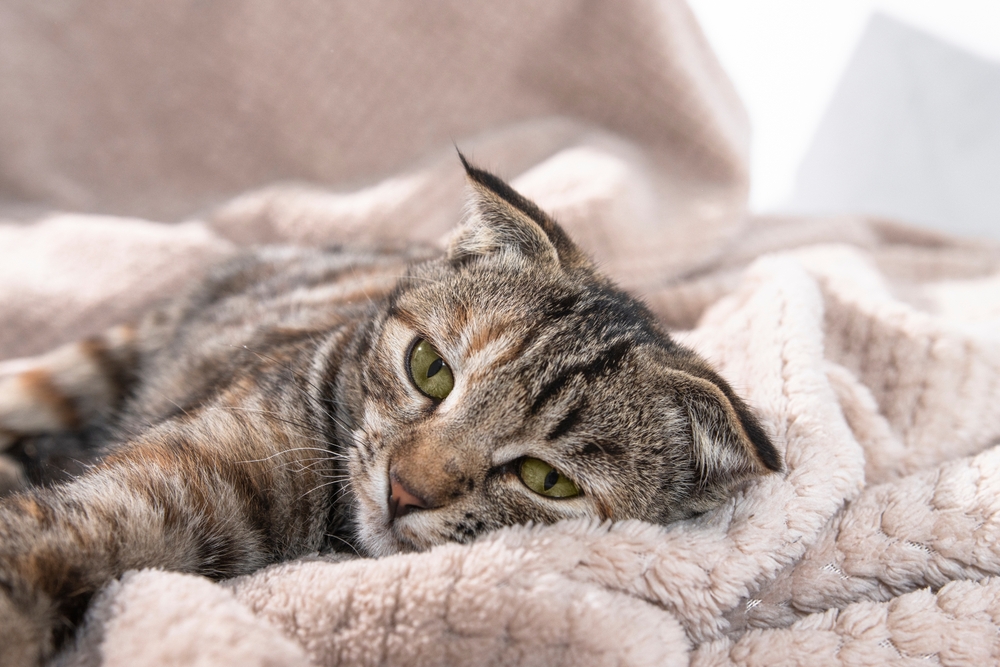
Many pet owners worry about keeping their cats healthy and safe. One threat to feline health is chlamydia, a bacterial infection that can lead to severe issues if not addressed. This blog post will explore what chlamydia in cats is, its symptoms, and most importantly, how feline vaccination plays a crucial role in prevention and management.
Keep reading to learn more about protecting your furry friend.
What is Chlamydia in cats?
Feline chlamydia, caused by the bacterium Chlamydophila felis, triggers severe conjunctivitis and can lead to upper respiratory infections in cats. This condition is a significant health concern for cat owners and shelters alike due to its impact on feline populations.
Cats suffering from this bacterial infection show symptoms such as eye discharge, sneezing, and coughing, which, if left untreated, could escalate into more serious health issues.
The role of vaccination against chlamydia in cats is critical for controlling the spread of this bacterium. Although considered a non-core vaccine, meaning it’s optional, it comes highly recommended for cats at risk or those frequently exposed to environments with high infection rates like shelters.
The vaccine aids in reducing clinical signs in infected cats and plays a substantial part in managing bacterial replication within feline communities. It offers a preventive measure that contributes significantly to maintaining cat wellness and preventing outbreaks of this disease among shelter-housed populations where its transmission is notably higher.
Symptoms
C. felis in cats often manifest signs of;
- Severe conjunctivitis: Characterized by red, swollen eyes and ocular discharge.
- Upper respiratory infections: Manifests as sneezing, coughing, and nasal discharge.
- Decreased appetite or fever: Causes discomfort associated with the felis infection.
Recognizing these symptoms early can lead to prompt treatment with antibiotics for cats, reducing the risk of complications.
How it is Transmitted
- Chlamydia in cats spreads mainly through close contact with infected secretions. Cats often contract the bacterium from one another by sharing litter boxes, grooming each other, or simply by being in close quarters, like shelter environments where the source of infection is common.
- Direct contact between cats with ocular infections is a typical pathway for transmission. Respiratory droplets carrying Chlamydophila felis can infect healthy cats when they inhale these particles, making places with high feline populations such as sheltered hotspots for the spread of chlamydia.
Risk if Untreated
Feline chlamydia, caused by C. felis, can lead to severe health complications if left untreated. Cats suffering from this bacterial infection may experience chronic conjunctivitis, eye infections and serious upper respiratory tract diseases.
Without timely intervention through antibiotics or vaccination, the clinical disease can worsen, making cats more susceptible to other infections and possibly leading to long-term damage to their eyesight or breathing capacity.
The Importance of Vaccination
Vaccination plays a key role in protecting cats from the serious effects of Chlamydia. It equips your pet’s immune system to fight off this infection effectively, ensuring their health and wellness.
Routine vaccination of shelter-housed cats against feline chlamydia and other respiratory agents has been shown to significantly reduce the prevalence and impact of these diseases.
Untreated feline chlamydia affects the individual cat’s health and poses a risk of spreading to other cats. This underscores the importance of both treating infected animals and vaccinating at-risk populations like those in shelters.
How they Work
Vaccines for feline chlamydia stimulate the cat’s immune system to recognize and fight against Chlamydophila felis, the bacteria causing this disease. After vaccination, if a cat encounters the actual bacterium, its immune system is already primed to respond more efficiently and effectively.
This results in either preventing the infection entirely or significantly reducing its severity. For instance, while it may not stop all symptoms of conjunctivitis or respiratory infections caused by this bacterium, vaccination can considerably lower their intensity and frequency.
This preventive approach means fewer sick cats and a reduced need for treatments like antibiotics, which are commonly used to battle chlamydial infections. By incorporating vaccines into routine veterinary care—especially for those cats in shelters where respiratory agents like chlamydia are more prevalent—veterinarians can help control outbreaks before they start.
It points to a strategy that saves on extensive treatment costs and supports overall feline health by tackling potential problems at their source. Moving forward from understanding vaccine mechanics introduces us seamlessly into exploring why vaccinating your pet is so beneficial.
Benefits of Vaccination
- Vaccinating cats against feline chlamydia can drastically reduce the spread of Chlamydophila felis, a bacterium responsible for serious conjunctivitis and respiratory infections.
- By opting for the chlamydia vaccine, cat owners help control bacterial replication and lessen clinical signs in affected pets, ensuring better health outcomes.
- Routine vaccination significantly benefits shelter-housed cats by protecting them against respiratory agents such as chlamydia, which is crucial given their close quarters living situation.
- Implementing vaccination supports individual pet health and plays a key role in public animal welfare by preventing potential outbreaks of Chlamydophila felis among cat populations.
- Although considered a non-core vaccine, it’s recommended for cats at higher risk of exposure to chlamydia, highlighting its importance in customizing preventive care specific to each cat’s needs.
Managing and Preventing Chlamydia in Cats
Effective management and prevention of Chlamydia in cats start with regular veterinary check-ups and prompt treatment. Ensuring your cat receives vaccinations, including the feline chlamydia vaccine, plays a crucial role in protecting them from this infectious disease.
Treatment Options
Treating feline chlamydia involves a course of oral and topical antibiotics to combat the infection. Veterinarians often prescribe these treatments after diagnosing chlamydial conjunctivitis or respiratory infections, ensuring effective management of the condition. Complete recovery requires adherence to the prescribed medication schedule, which may vary depending on the severity of the infection in cats.
Living and Management
Living with and managing feline chlamydia involves routine vaccination to protect cats against respiratory infections, especially for shelter-housed cats where the risk is higher. Vaccines, such as the feline chlamydia vaccine, play a key role in preventing illness and controlling the spread of Chlamydophila felis.
Regular vet visits allow for early detection and treatment with antibiotics for cats, showing symptoms of conjunctivitis or respiratory issues caused by this bacterium.
Owners must customize their cat’s vaccination schedule based on their pet’s lifestyle, whether indoor or outdoor, to ensure comprehensive protection against various diseases, including chlamydial infections.
Following a course of oral and topical antibiotic treatments helps treat infected cats effectively. Committing to preventive care through vaccinations enhances health and also reduces clinical signs in those already affected by Chlamydophila felis.
Preventative Measures
- Regular vaccination, including the feline chlamydia vaccine, plays a critical role in preventing chlamydial infections. Vaccines work by controlling the spread of Chlamydophila felis and reducing clinical signs in infected individuals.
- Routine check-ups with a veterinarian can help identify symptoms early. Cats showing signs of conjunctivitis or respiratory issues should be examined promptly to prevent complications.
- Providing shelter-housed cats with respiratory agents vaccines, such as those against chlamydia, has shown effectiveness in managing health within populations at risk for exposure.
- Implementing environmental sanitation measures reduces the risk of infection spread among cats. This includes regular cleaning of living spaces and quarantine procedures for new or sick animals.
Ensure Your Feline Friend’s Protection Against Chlamydia Today!
Chlamydia in cats, a bacterial infection, poses serious risks but can be managed effectively with vaccination. Vaccines for feline chlamydia offer a practical solution to prevent the spread of this disease and lessen its severity.
Have you ensured your cat’s vaccinations are up-to-date? Protecting them from diseases like chlamydia keeps them healthier and happier. To safeguard your furry friend’s health, book an appointment with Pine Ridge Pet Clinic today for their vaccination needs.




